- Bernard Preston homepage
- Fast dinners
- Recipes for Cooking Kale
Recipes for cooking kale
These recipes for cooking kale will enable you to escape the onset of the macular-degeneration that frequently is associated with aging; the prevalence is more than double that of Alzheimer's Disease.
A deficiency of three phytochemicals is at the root of the most common cause of blindness in the older person. They are lutein, zeaxanthine and oleocanthal. L-dopa appears to come into the equation too.
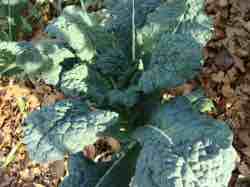
This page was last updated by Bernard Preston on 7th January, 2023.
I find it disturbing that our various bread recipes are the most
popular at Bernard Preston's site but those for cooking kale languish
at the very bottom. It should be the other way around, fine though our
loaves are; especially because 100% wholemeal is so rich in lignans and vitamin E.
But it is the dark-green leafy vegetables, corn and eggs that are so important in eliminating the most common cause of blindness.
Even the most ardent lover of kale would admit that it has little flavour of its own. Yet because it is one of the richest sources of the carotenes that promote wellness and prevent disease, it should be eaten several times a week; in fact daily if you're a nutrition-nut and want to enjoy a long life without medication.
Kale is the best source of lutein from greens by a long mile and has some zeaxanthin too; we add extra-virgin olive oil for the oleocanthal. The tomatoes have another phytonutrient called a lycopene that helps prevent prostate disease and generally contributes to the flavour.
We use chickpeas for protein but you could add lima beans, or any other legume. Do not let any recipe kill your creative-side; make this your salad.
Add freshly-squeezed lime or lemon juice as for all salads and a few optional extra bits and pieces; garlic, chilies and a couple teaspoons of fatty fish perhaps.
Garlic has the allicin, chilies the capsaicin and limes the vitamin C; and the fatty fish the omega-3. Your recipes for cooking kale have become a veritable medicine chest. It is interesting that researchers have now found that type 2 diabetes can be brought into complete remission without the use of drugs; by turning to a largely plant-based diet and whole foods[2]. Could the same be said for macular degeneration?
The longer you have had any disease the less likely that food as medicine will bring about complete remission; but it will certainly help.
And its easy to throw these recipes for kale together in no time at all.
Recipes for cooking kale
Recipes for cooking kale take a doubtful pretender-princess to the throne she richly deserves.
- A good handful of fresh-kale per person.
- A tablespoon of olive-oil.
- A lime or lemon.
- A clove of garlic and a slither of red-jalapeno or peppadew.
- A cup of cherry-tomatoes.
- A cup of chickpeas; rinse them well if they are canned.
- A couple tablespoons of feta-cheese and a dozen sliced and depitted olives.
- A small chunk of pilchard, sardine, or salmon; in Holland we might have used herring or smoked-mackerel.
Gathering these ingredients together might take the longest time but in fact we have them virtually always in our home and garden; you either eat these medicines daily or you queue up at the pharmacy instead. Take your pick.
For me and I am very privileged it starts with a short walk in the Garden Cathedral called forest bathing, basket in hand. For two persons I have a pretty shrewd idea of how much salad we can enjoy, so I pick perhaps a dozen young-fronds of three different kinds of kale.
Frankly that which I see in the greengrocer is usually appalling so it comes as no surprise that most folk turn up their noses; but it is so easy to grow.
Then I will pluck a good cupful of cherry tomatoes, a jalapeno chili and a lime or lemon; and perhaps a few leaves of sweet basil just because we love their flavour so much. Wash them all several times to get the snails and other creepy-crawlies off.
- Strip or cut the leaves off the central kale-stalk and chop finely. Into your serving bowl pour the juice of half a lime over the greens. Use a spoon to dunk and smear them well.
- Using a heavy glass crush the olives forcing the pits out; they go in the tumbler. Do not miss any; then slice them.
- Warm a large heavy-bottomed skillet on low heat. Add the olive oil, garlic and jalapeno; and then a few slithers of lime zest and the chunks of fatty fish. Saute for a minute or two.
- Toss in the sliced olives, kale and lime juice; and a tablespoon of water. Then turn up the heat for a few minutes with the lid on.
- Add the chickpeas and tomatoes. Depending on whether you want a hot dish or a salad, heat for another couple minutes.
- Serve with feta cheese, sprigs of parsley, and lime or lemon wedges to make it pretty.
Pitting olives is an art in itself.
Indian Saag recipe
Let's be honest, kale is rather dull. This Indian Saag recipe with cumin and coriander will give your greens the most delicious flavour; it's very simple and you can enjoy it either as a vegetarian dish or using a chicken-bones stock.
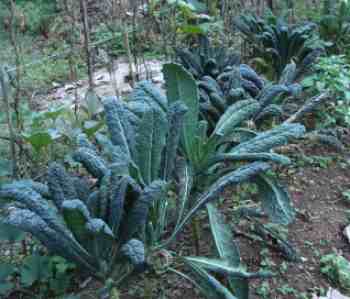
Along with spinach and lettuce, kale is one of the three basic greens that should be in every garden. Dark-green leafy vegetables are the mainstay of at least two of our three meals daily. It's the only way I can escape from a stubborn constipation too.
Kale and spinach sauce
Most carbs and in particular those that have been refined have little taste. So most commercial brands of vinaigrette have too much salt and artificial flavouring. The trick is to dicky your food up with your sauces that lower their glycemic index so they don't give you a blood-glucose rush.
This kale and spinach sauce you can blend up in less than ten-minutes; to go on your pasta for example.
Our kale and almonds salad is another great favourite.
Use your own imagination for making up recipes for cooking kale; it's so versatile.
Chickpeas
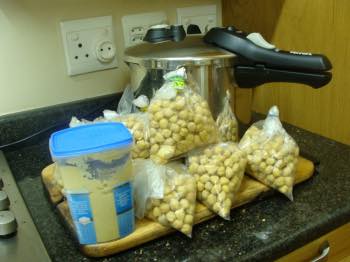
Chickpeas are the world's most popular legume and for good reason; they are inexpensive, readily available and a wonderful source of vegetable protein. Toss in a handful whenever you are cooking kale.
We soak them overnight, pressure-cook for twenty-five minutes and then rinse thoroughly; and freeze so they are readily available, mostly for our authentic hummus recipe seen in a tub in the foreground. It's a wonder with any salad.
Cooking chickpeas is a breeze if you have a pressure-cooker; a quarter of the price compared to cans, no salt and zero preservatives. If concerned about antinutrients you can also ferment them.
I confess to being neurotic about the chemicals added to our food these days. Right now I'm treating a patient with Parkinson's disease; nitrates, a common preservative target the cells in the substantia nigra. There is no cure but fava beans eaten daily will provide sufficient L-dopa.
I have never seen them in the green grocer so we found out how to plant broad beans, as they are sometimes known.
Macular degeneration
It is estimated that nearly two million Americans are needlessly blind, and many more partially sighted; all because they refuse to eat their recipes for cooking kale and other greens, and so get age-onset macular degeneration and cataracts. Smoking grossly adds to the issue.
It is a complex disease with several variants but much has to do with the vessels that bring fresh nutrients and remove waste products from the retina; inadequate blood circulation and generalised inflammation are at the heart of this very disabling disease. That is why smoking is central to AMD.
It is the richest source of lutein; I would rather enjoy my greens than have a doctor poke me in the eye with a scalpel or laser beam. What do you think? The nutritional value of kale is so important.
Researchers state that the likelihood of vision loss from age-related macular degeneration cannot be reduced by high dose vitamin supplementation; it is permanent. Improvement once you have the disease is limited. How much better to enjoy the foods like kale, spinach, and zucchini on a regular basis; corn and eggs too are very important.
Prevention before acquiring AMD is always better than the non-existent cure.
- Prevalence of Age-Related Macular Degeneration in the United States[3].
Inflammation
Researchers have found that over and above an inadequate blood supply
to the retina of the eye, generalised inflammation in the body is a
factor in macular degeneration. Like Parkinson's Disease it is a neurological condition. Avoid seed oils unless they are cold-pressed.
The three most important ways to reduce inflammation are as follows.
- Daily consuming foods containing those nutrients like lutein and zeaxanthin that scientists have proved give a continual low level of natural anti-inflammatory protection.
- Decreasing the ratio of omega-6 to 3 from your food; the simplest way is to regularly enjoy fatty fish and avoid seed oils.
- Enjoying foods rich in anti-inflammatory minerals like magnesium and zinc, and vitamins like C and E; read more about lime nutrition; do you know why the British sailors were called limeys?
- Vitamin E is so important.
- Food and inflammation.
- Anti inflammatory omega-3.
- Magnesium heart.
Recipes for cooking kale with a little added fatty-fish makes an excellent start to this step up to better state of the eyes and in fact the whole body. If a life without medication is your desire, think first of recipes for cooking kale.
Find the links to those topics highlighted in bold by copying and pasting into the Site Search function in the navigation bar above.
Oleocanthal
Oleocanthal is another phytochemical that researchers have discovered gives scientifically-proven protection, along with lutein and zeaxanthin, against macular degeneration. It's not found in kale but one adds it when using recipes for a green salad; olive oil.
The only food where you can get it is in extra-virgin olive oil; nowhere else. Is it any wonder those following the Mediterranean food plan live longer? Two of the five Blue Zone countries are Ikaria and Sardinia where ten times as many folk enjoy strong and vigorous old age; they relish many dishes rich in oleocanthal.
Refined olive-oils have had the oleocanthal removed because it gives a burn in the back of the throat; confirmation that this is the real McCoy, but for those demanding that all their food is smooth and sweet, it's an irritant.
Once food-companies get hold of olive oil, wheat and honey, and we could add another ten thousand, they utterly ruin it for us. Did you know that millers can label their flour as wholemeal provided they don't remove more than 40% of the goodies? That's where most of the germ and bran are to be found; the home of the lignans, vitamins and fatty acids too, not to mention the the minerals, protein and phytonutrients.
And they have the audacity to call it "wholemeal;" worse, it's allowed by international law. Buyer beware remains the rule. But a slice of bread made with 100% flour with your recipes for cooking kale makes an excellent mix.
Lutein
Lutein is a carotene found in dark-green leafy vegetables. Enjoy your recipes for cooking kale and spinach daily, with a slosh of olive oil, and you have almost certain protection against macular degeneration; unless you're a smoker.
Read more about the lutein benefit; and yet further research at "zeaxanthin macular degeneration."
Eggs Hilton
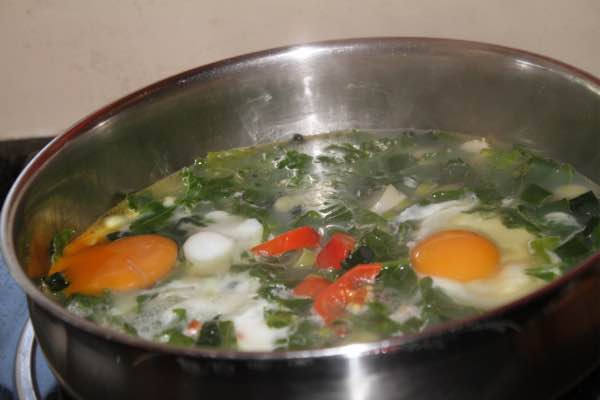
Copy and paste "zeaxanthin macular degeneration" into Site Search in the main menu for more information.
Eggs Hilton is our other favourite dish using recipes for cooking kale; poach an egg on your steaming-greens.
Broad beans
It has been noted that those taking dopamine for Parkinson's disease are less likely to suffer from macular degeneration; and that broad beans are an alternative for those wanting to use food as medicine.
Broad beans are the only readily available source of Levodopa, the precursor of the neurotransmitter.
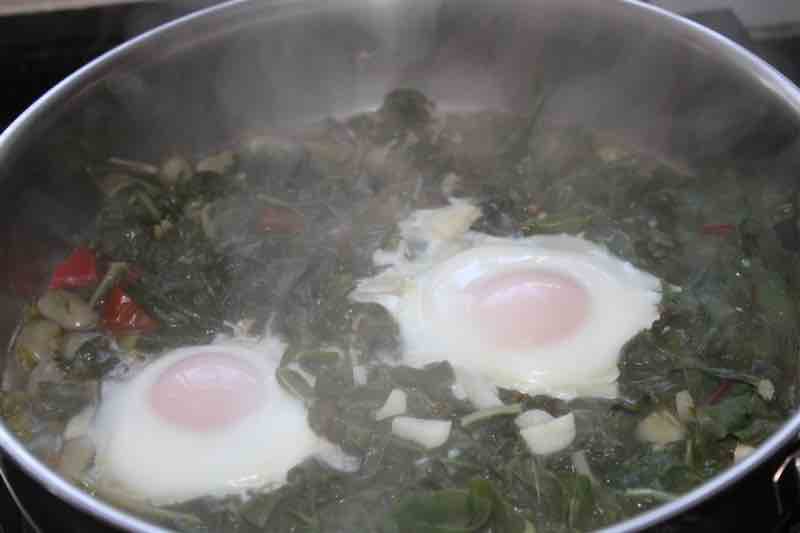
Can you see the broad-beans in our variant of the great Italian breakfast? We call it Eggs Parkinson's disease.
Bernard Preston
Bernard Preston is a nut, some say, for having a desire for a life without medication, a love of outdoor living and the backyard permaculture fantasy; fancy a solar farm on your roof and fresh free-range eggs every day? It can be achieved.
There's an important distinction between a love of a good lifestyle and food neurosis; understand it.
When browsing use right click and "Open Link in New Tab" or you may get a bad gateway signal.
Newsletter
Our newsletter is entitled "create a cyan zone" at your home, preserving both yourself and Mother Earth for future generations; and the family too, of course. We promise not to spam you with daily emails promoting various products. You may get an occasional nudge to buy one of my books.
Here are the back issues.
- Lifestyle and ideal body weight
- What are ultra-processed foods?
- Investing in long-term health
- Diseases from plastic exposure
- Intensive lifestyle management for obesity has limited value
- A world largely devoid of Parkinson's Disease
- The impact of friendly bacteria in the tum on the prevention of cancer
- There's a hole in the bucket
- Everyone is talking about weight loss drugs
- Pull the sweet tooth
- If you suffer from heartburn plant a susu
- Refined maize meal and stunting
- Should agriculture and industry get priority for water and electricity?
- Nature is calling
- Mill your own flour
- Bake your own sourdough bread
- Microplastics from our water
- Alternative types of water storage
- Wear your clothes out
- Comfort foods
- Create a bee-friendly environment
- Go to bed slightly hungry
- Keep bees
- Blue zone folk are religious
- Reduce plastic waste
- Family is important
- What can go in compost?
- Grow broad beans for longevity
- Harvest and store sunshine
- Blue zone exercise
- Harvest and store your rainwater
- Create a cyan zone at your home
Did you find this page interesting? How about forwarding it to a friendly book or food junkie? Better still, a social media tick would help.
- Bernard Preston homepage
- Fast dinners
- Recipes for Cooking Kale
Address:
56 Groenekloof Rd,
Hilton, KZN
South Africa
Website:
https://www.bernard-preston.com